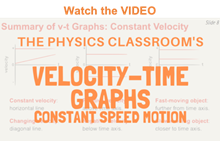11. How Do You Know on a Velocity Vs. Time Graph if the Acceleration Is Positive or Negative?
The Meaning of Slope for a v-t Graph
Equally discussed in the previous part of Lesson four, the shape of a velocity versus time graph reveals pertinent information about an object's acceleration. For example, if the acceleration is zero, then the velocity-fourth dimension graph is a horizontal line (i.east., the slope is null). If the dispatch is positive, and then the line is an upward sloping line (i.due east., the slope is positive). If the acceleration is negative, then the velocity-fourth dimension graph is a downward sloping line (i.e., the slope is negative). If the acceleration is great, then the line slopes upwards steeply (i.east., the slope is great). This principle can be extended to any motion conceivable. Thus the shape of the line on the graph (horizontal, sloped, steeply sloped, mildly sloped, etc.) is descriptive of the object'south motion. In this part of the lesson, we will examine how the actual slope value of whatsoever straight line on a velocity-time graph is the acceleration of the object. Consider a car moving with a constant velocity of +ten m/s. A car moving with a constant velocity has an dispatch of 0 thousand/s/south. And so in this example, the slope of the line is equal to the acceleration of the velocity-fourth dimension graph. Now we will examine a few other graphs to run into if this is a principle that is truthful of all velocity versus fourth dimension graphs. At present consider a car moving with a changing velocity. A car with a changing velocity will have an acceleration. In both instances in a higher place - the constant velocity motion and the changing velocity motility, the slope of the line was equal to the acceleration. Every bit a last illustration, nosotros will examine a more complex case - a two-phase motility. Consider the motion of a motorcar that first travels with a constant velocity (a=0 m/s/s) of 2 m/due south for iv seconds and and then accelerates at a rate of +2 m/s/due south for four seconds. That is, in the kickoff four seconds, the automobile is not changing its velocity (the velocity remains at two thou/s) and and so the motorcar increases its velocity past 2 m/s per second over the next 4 seconds. The velocity-time information and graph are displayed below. Observe the relationship between the slope of the line during each four-second interval and the corresponding acceleration value. A motility such as the i to a higher place further illustrates the of import principle: the slope of the line on a velocity-time graph is equal to the acceleration of the object. This principle can be used for all velocity-time in order to determine the numerical value of the acceleration. A single example is given beneath in the Cheque Your Agreement section. Analyzing a Constant Velocity Motility

The velocity-time data and graph would look similar the graph beneath. Note that the line on the graph is horizontal. That is the slope of the line is 0 yard/south/s. In this example, it is obvious that the slope of the line (0 m/southward/southward) is the aforementioned as the dispatch (0 m/s/s) of the auto.
Time
(s)Velocity
(thousand/southward) 0 10 ane 10 2 10 3 10 iv ten 5 10
Analyzing a Changing Velocity Motion
 The velocity-time data for this motion show that the automobile has an acceleration value of 10 g/southward/s. (In Lesson half dozen, we volition larn how to chronicle position-time data such equally that in the diagram above to an acceleration value.) The graph of this velocity-time data would look like the graph beneath. Note that the line on the graph is diagonal - that is, it has a slope. The slope of the line tin can exist calculated as 10 m/south/due south. It is obvious in one case once again that the slope of the line (10 m/s/s) is the same every bit the acceleration (10 thousand/s/south) of the car.
The velocity-time data for this motion show that the automobile has an acceleration value of 10 g/southward/s. (In Lesson half dozen, we volition larn how to chronicle position-time data such equally that in the diagram above to an acceleration value.) The graph of this velocity-time data would look like the graph beneath. Note that the line on the graph is diagonal - that is, it has a slope. The slope of the line tin can exist calculated as 10 m/south/due south. It is obvious in one case once again that the slope of the line (10 m/s/s) is the same every bit the acceleration (10 thousand/s/south) of the car.
Time
(s)Velocity
(grand/s) 0 0 one 10 ii 20 3 30 iv 40 5 fifty
Analyzing a Two-Stage Move
Time
(s)Velocity
(yard/s) 0 2 1 ii 2 two three ii 4 ii v 4 6 6 7 viii 8 10
From 0 due south to 4 s: slope = 0 thousand/s/south
From 4 s to 8 due south: slope = 2 m/s/due south Investigate!
Try experimenting with different signs for velocity and acceleration. For case, try a positive initial velocity and a positive acceleration. And so, contrast that with a positive initial velocity and a negative dispatch.
We Would Like to Suggest ...
 Sometimes it isn't enough to only read well-nigh it. You accept to collaborate with it! And that's exactly what you do when you lot use ane of The Physics Classroom's Interactives. Nosotros would similar to advise that you combine the reading of this page with the employ of our Graph That Motion or our Graphs and Ramps Interactives. Each is plant in the Physics Interactives section of our website and allows a learner to apply concepts of kinematic graphs (both position-time and velocity-time) to draw the motion of objects.
Sometimes it isn't enough to only read well-nigh it. You accept to collaborate with it! And that's exactly what you do when you lot use ane of The Physics Classroom's Interactives. Nosotros would similar to advise that you combine the reading of this page with the employ of our Graph That Motion or our Graphs and Ramps Interactives. Each is plant in the Physics Interactives section of our website and allows a learner to apply concepts of kinematic graphs (both position-time and velocity-time) to draw the motion of objects.
Bank check Your Understanding
The velocity-time graph for a two-phase rocket is shown below. Utilise the graph and your understanding of slope calculations to determine the dispatch of the rocket during the listed time intervals. When finished, use the buttons to see the answers. (Help with Slope Calculations)
- t = 0 - i second
- t = 1 - 4 second
- t = iv - 12 second
Source: https://www.physicsclassroom.com/class/1DKin/Lesson-4/Meaning-of-Slope-for-a-v-t-Graph
0 Response to "11. How Do You Know on a Velocity Vs. Time Graph if the Acceleration Is Positive or Negative?"
Post a Comment